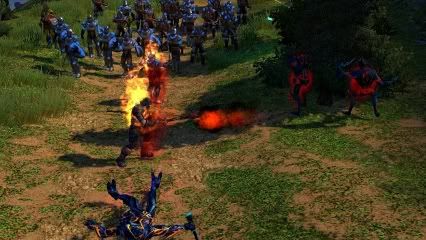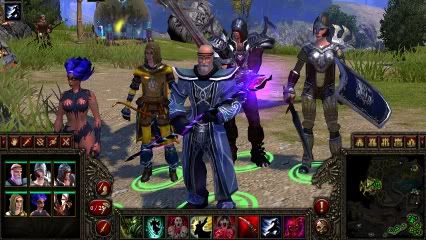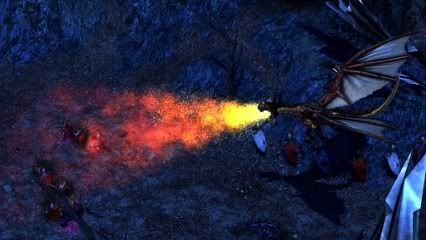
- Format: PC
- Unleashed: Out Now
- Publisher: Nordic Games
- Developer: DreamCatcher Interactive
- Players: 1 – 6
- Site: spellforce.jowood.com/sf2/fid/
Expansion packs are great. In a world being rapidly overwhelmed by DLC that tacks very little onto a game for a quarter of the original asking price, it’s nice to see an expansion pack walk out of the blue with significant new content and an appropriate price (plus this can be played as a standalone title). Faith in Destiny is the second retail add-on for Spellforce 2, a real-time strategy role playing hybrid game released in 2006. Will this stand-alone expansion breathe new life into the series or simply blow warm air over a decaying carcass?
We’ll go straight for the jugular: Spellforce 2: Faith in Destiny is an expansion pack for a six year old game and shows this painfully. It feels like you’re playing the game through a time machine, with visuals that are more outdated than MySpace. Everything looks rough by today’s standards. Character models look particularly jagged and are tragically highlighted in the many close-up mid-mission cutscenes that use the in-game graphics. And we’re not entirely sure what happened with the dwarves, with each one sporting a hilarious Max Payne 1 style constipation grimace permanently on their face. It just looks old, and definitely not like a polished product released in 2012. Our first thought when playing it was that it reminded us of Warcraft 3, which would have been a great compliment if the game were released 10 years ago.

Staying cool when you’re on fire: the mark of a true hero.
The game sees you guiding a custom hero through several maps solving quests. Customisation is incredibly basic, with the initial choice only being which one of the stock heads you want your hero to wear on his shoulders. And it is only his shoulders, as there are no female hero options. The best part of customisation is the assignment of points to your abilities. With each level gained you earn a point to assign in one of three skill trees: combat, Shaikan or magic. Combat and magic are fairly self-explanatory and provide several options for warrior and casting roles. Shaikan grants abilities to buff your hero temporarily and summon things like flying axes to fight at your side. From here you can further customise your look from the bits of armour and equipment you find when questing.
Speaking of quests, Faith in Destiny is full of them. As an RPG RTS hybrid, each level drops you on a map to explore and usually guides you towards NPCs who have tasks for you to complete. There’s plenty to do, with many of the usual mundane side quests that involve killing and object retrieval strewn around each level. Of course to proceed in the game you’ll want to advance the main quest, an uninteresting and entirely unmemorable storyline that places you as the hero who has an unforetold and significant destiny. It will eventually throw you together with a party of heroes, each with a panel of abilities that they earn and improve whilst levelling up. It is typically mundane RPG fodder, so don’t expect to be immersed in a compelling world of intrigue and suspense. Events just seem to happen in between mouse click massacres.

Our crew of posing demon spankers.
Something that caught our interest early on was the ability to drop the camera down from the bird’s eye strategy cam and pursue your hero from a third-person perspective. In this mode, movement of your hero is mapped to our old friends W, A, S and D, giving you a better sense of direct control. Unfortunately, this option is completely wasted as the point-and-click combat controls remain unchanged. We were hoping to precisely aim magic spells and time sword strikes, but instead we just have RTS combat controls from a significantly hampered camera angle. We found no benefit to the third-person camera at all, which is a real shame and a bitter tease at what the game could have been.
Faith in Destiny is littered with bad design choices like this one. Units have too much health which drags battles out for far too long. It’s so unsatisfying to establish a base, build a big doom blob of various units and carefully micromanage them into combat, only to see their attacks barely graze enemy forces. It also feels like a mistake to have every unit in your army level up with the hero, as it puts a cap on your army’s effectiveness if you haven’t levelled adequately. It would have been much better to have every basic unit, allied and enemy, set at a constant effectiveness, varying the difficulty at later stages with high enemy populations and different units. As it is, you don’t ever really feel like you have the upper hand.

Design gripe #10: This dragon refuses to breathe fire when he’s being ridden.
There is a multiplayer versus mode but there was no-one playing when we tried to find a game. However, this might pick up as the game was only just released this week. From our skirmish battles with the AI, the game plays like an RTS online. Build base, gather supplies, amass army and attack the enemy. If the game lasts long enough you are able to summon a pre-selected hero to lead your charge. It’s uninspiring but provides a more interesting opponent to fight against if you can find a person at the other end of the line.
Spellforce 2: Faith in Destiny is like squeezing that lemon you’ve had at the back of the fridge for ages directly into your mouth. You kind of know what to expect and you won’t really want to taste much of it. It’s an old game released far, far too late. The RPG elements don’t go beyond shallow cosmetic customisation options, questing, and a pleasantly adequate, yet not ground breaking level up system. The elderly graphics make this a particularly hard one to swallow and do nothing to mask the dull and often badly designed quests. There is a lot of content here that more than expands on the original game. It just would have been nice to have seen it in a more relevant time window, 2008 at the latest.



Comments